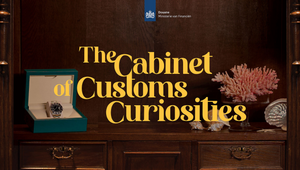
How 1980S Technology Transformed Our World, and Why It’s about to All over Again

Communicating and marketing for brands need to be re-aligned as realities converge in the online and offline worlds, shares Media.Monks’ Tim Wood, Executive Creative Director, Australia
Are you watching Stranger Things? Based on Netflix's viewership numbers, you probably are. But if you’re not, and without spoiling anything, Stranger Things is set sometime in the 1980s in the quaint, rural-esque town of Hawkins. However, the lives of the people in Hawkins quickly get turned upside down (pun intended) when they learn that everything isn’t what they thought.
Of course, Stranger Things is fiction. But there was something else that happened back then that really did add a new dimension to our world; today we call that thing the internet. Over the last century, few developments have been as transformative. But for those of us who were around back then, it didn’t seem that way at first. With its new (but sometimes unreliable) technology combined with excruciatingly slow download speeds, the internet didn’t seem to hold much commercial value.
Then, one day we all blinked and everything changed.
Transformation can sometimes feel like that. Things that appear a long way off can suddenly be on top of you before you realize. And while we’ve all now become very comfortable with the internet, there’s another change coming that promises to be as transformative as the internet’s arrival; it’s something called ‘virtualisation’.
What is Virtualisation?
Much like the multi-dimensions in Hawkins, our offline and online selves are converging. Thanks to things like constant 5G connectivity and smartphones, our physical and digital identities are conflating. Virtualisation marks the moment at which they become indistinct from each other. Put simply, soon there will be no meaningful distinction to be made between who we are offline and online because we’re constantly connected.
Why does this matter for brands? It matters because communicating and marketing in a post-virtualisation world need to be rethought. As soon as you realise there’s no offline/online distinction to be made, many of the models of communication we’ve been using quickly become unfit for purpose.
Take the classic customer funnel. Layer virtualisation over it and it stops making sense. Broadly speaking, people might experience the same phases (awareness, consideration, purchase, etc) but any sense of a linear or near-linear progression goes right out the window. How much sense does a marketing calendar make (with its peaks and troughs) when customers are ‘always on, always there’? Your marketing activities may ebb and flow, but your customers’ connection to digital does not.
So, what are the new models for communicating in a virtualised world? If you’re not sitting down you might want to; there are none, yet. Virtualisation demands a crystal-clear understanding of emerging consumer behaviours because, unlike previous eras of business transformation, marketers can’t just buy their way into virtualisation. Authentic engagement calls for the deft orchestration of transformative new tools and technologies, and a new breed of talent that can deliver on our consumers’ quickly evolving needs, at speed.
And that last word - speed - is critically important.

How Agile is Your Organisation?
If you haven’t thought about this, you soon will because business agility is about to become the key battleground for companies that want to remain competitive. In addition to operational agility, marketers are also going to need to be much more agile in the way they construct their communication plans and flight their work.
Perhaps a more helpful way to think about communicating in a virtualised world is to adopt a UX mindset. Rather than the linear delivery of your typical campaign (ie. big TV ad that trickles down through other media), you need to consider all the points in a possible journey and realise that your customer might begin their journey with you at any of them. Are we witnessing the end of the TV ad? Of course not. In fact, big ideas and creative thinking are needed now more than ever.
Virtualisation means the ‘big idea’ is no longer big enough; you still need one, but you need to think about it very differently.
How Agile are Your Partners?
As with your own agility, if you haven’t assessed the operational agility of the companies you depend upon, now might be a very good time to get started. Also worth interrogating is how well they work with each other, and how many partners you have. Needless complexity, friction between partners, or relying on too many third parties are all likely to significantly impede your ability to compete. The questions you could ask about your business partners are:
● Do they incorporate future-focused data in their planning and operations, or are they informed only by historical data?
● Can they flex and provide different sorts of talent at a moment’s notice?
● Can they demonstrate an ability to rapidly change tack as new information comes to hand, or do they only talk about their ‘processes’ (which are by definition, fixed)?
● Do they offer you multiple ways to engage with and use their services?
● Are they internally aligned and connected as a business, or do they operate in silos?
Virtualising Your Brand
Virtualisation is likely to feel very messy at first. And that’s okay; this is not Hawkins, our world is not ending. But to win in this new era, marketers must wholly embrace that complexity with an openness to new models and ways of thinking and working.
Critical will be the ability to access different types of talent quickly and deploy those people in more flexible working models to meet rapidly changing demands. In practice, that could look like using embedded or hybrid/remote teams that can quickly scale up and down. Equally important will be the ability to scale up and down asset production because in a virtualised world you need to ‘show up’ everywhere, all the time. Does your current production capability give you the ability to do that efficiently and cost-effectively?
Like a supernatural creature from Stranger Things, virtualisation might seem intimidating, and in some ways it is. But it also represents an incredibly exciting opportunity for those brands that choose to step forward rather than stubbornly insist this ‘doesn’t apply to them’. However you might personally feel about virtualisation, know that it is coming, and soon.
Just don’t blink, or you’ll miss it.















